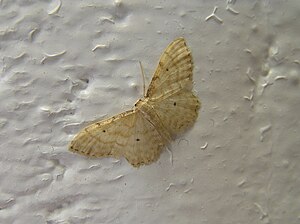Gray-edged dwarf tension
| Gray-edged dwarf tension | ||||||||||||
|---|---|---|---|---|---|---|---|---|---|---|---|---|

Gray-edged dwarf moth ( Idaea fuscovenosa ) |
||||||||||||
| Systematics | ||||||||||||
|
||||||||||||
| Scientific name | ||||||||||||
| Idaea fuscovenosa | ||||||||||||
| ( Goeze , 1781) |
The Graurandige dwarf tensioner ( Idaea fuscovenosa ) even Busch corridor clamps or bushes-floor retail release called, is a butterfly ( moth ) from the family of the tensioner (Geometridae).
features
The moths have a wingspan of 14 to 19 millimeters. The forewings are relatively wide, the rear edge of the hind wing is slightly concave between the central veins. The basic color is whitish to light brown. The costal edge can correspond to the basic color, but is more often gray-brown on the root half. The inner and outer transverse lines are usually very clear, the central band is somewhat wider and more washed out, as is the wavy line. Inner and outer transverse line as well as the central band end at the costal margin in very distinct black spots. The discal spots are black and practically always present on the fore and hind wings. On the forewings, they lie in the middle band or slightly apicalward from the middle band. On the hind wings, however, they are clearly separated from the central band at the roots. Often there are also seam marks.
The egg is initially light red and turns bright red shortly before the egg caterpillars hatch. It is flattened at both ends, the outside is provided with a regular mesh pattern.
The caterpillar is black-brown and has yellow or ocher-colored spots. It is relatively short and becomes a little thinner towards the front end. It has clear constrictions and lateral keels. The back line is light brown and darkly bordered at the back. The middle segments have diamond spots. The ventral side, on the other hand, shows crescent-shaped, light brown spots arranged in rows.
The pupa is reddish brown and has greenish wing sheaths. The segment incisions, on the other hand, are a little darker, as is the cremaster .
Geographical distribution and habitat
The species is widespread in Central and Southern Europe. However, it is usually not frequent and in Central Europe the occurrences are usually small and scattered. In the north the distribution area extends to England and Ireland, Denmark, southern Sweden and the southern Baltic States ; in the west from the Iberian Peninsula to Asia Minor , the Ukraine, southern Russia and the Caucasus . It is also found on the large Mediterranean islands of Corsica , Sardinia and Sicily . In Corsica, the nominate subspecies is represented by the subspecies corsula Schawerda, 1929. Earlier reports from North Africa are now assigned to the species Idaea bigladiata . In the north of the distribution area, the species occurs from sea level to about 500 meters above sea level. In the southern Alps it rises to an altitude of 1000 meters, in Corsica up to 2000 meters. The species is xerothermophilic, which means that it prefers dry and warm habitats. In the north of the distribution area it is usually limited to rows of hedges exposed to the sun, dry forests or forest edges, grassy areas with lots of moss, gardens or uncultivated land.
Phenology and way of life
The species is univoltin , which means that only one generation is formed each year. The moths fly from mid-June to mid-August. They rest in hedges and in the grass during the day and are easily startled. They are nocturnal and are attracted by artificial light sources. The caterpillars feed on various trees and bushes as well as herbaceous plants and mosses, whereby they prefer fallen leaves and withered plant material. Oaks ( Quercus ) and Rhytidiadelphus triquetrus (Großes Kranzmoos) are proven . In breeding, however, they also eat dry leaves of blackthorn ( Prunus spinosa ), Acker-Gauchheil ( Anagallis arvensis ), dandelion ( Taraxacum officinale ), blackberries ( Rubus fruticosus agg.), Knotweed ( Polygonum aviculare ), rennet ( Galium ), ampfer ( Rumex ), thyme ( Thymus ), garden lettuce ( Lactuca sativa ), willow ( Salix ) and common yarrow ( Achillea millefolium ) The caterpillars grow very slowly and overwinter. They pupate in May of the following year.
Systematics
The species was first scientifically described by Johann August Ephraim Goeze in 1781 under the name Phalaena Geometra fuscovenosa . Some misspellings in the literature (e.g. fusciovenosa and fuscovenosata ) are not available in the sense of zoological nomenclature (nomina nulla = "non-names").
Danger
The species is considered not endangered in Germany. Only the city-state of Hamburg lists the species in category 2 (endangered), the Saarland in category 3 (endangered). In Bavaria and Lower Saxony, the species is classified as potentially endangered if habitat destruction continues.
swell
literature
- Axel Hausmann: The Geometrid moths of Europe, 2nd Sterrhinae. In A. Hausmann (Ed.): The Geometrid Moths of Europe 2. Apollo Books, Stenstrup 2004, ISBN 87-88757-37-4
- Walter Forster , Theodor A. Wohlfahrt : The butterflies of Central Europe. Volume 5: Spanner. (Geometridae). Franckh'sche Verlagshandlung, Stuttgart 1981, ISBN 3-440-04951-5 .
- Günter Ebert (Ed.): The butterflies of Baden-Württemberg Volume 8, Nachtfalter VI (Spanner (Geometridae) 1st part), Ulmer Verlag Stuttgart 2001. ISBN 3-8001-3497-7